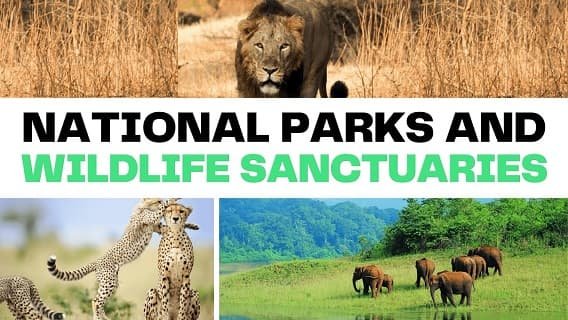The world’s wildlife is its principal natural heritage. As human activity has become more industrialized and deforested, it has become more difficult for animals to survive.
That’s why we have national parks, biosphere reserves, animal sanctuaries, and other protected areas to protect and preserve our country’s natural history. When we talk about a wildlife sanctuary, we’re talking about a place that gives wild creatures a safe haven and ideal circumstances in which to thrive.
However, the national park safeguards the whole ecosystem, including the local flora, animals, scenery, and so on. Finally, protected regions known as biosphere reserves are indeed the ones most likely to keep the species’ plant, animal, bird, and microbe diversity intact.
Read on for an effort at explanation of the distinction between a national park and a wildlife sanctuary.
What is wildlife sanctuary?
As its name implies, a wildlife sanctuary is a protected area where species such as mammals, birds, reptiles, and insects may roam free. Wildlife refuges are places where wild animals, particularly rare and endangered ones, may go to live out their natural lives undisturbed and help sustain the local people.
Rangers or guardians are sent to the sanctuary to ensure the area is being properly managed. They protect wildlife from human threats including poaching, harassment, and predators.
Wildlife sanctuaries are classified as Category IV protected areas by the International Union for the Conservation of Nature.
What is a national park?
A national park is a protected area set aside by the government to preserve its natural, cultural, or historical resources, including its wildlife and biodiversity. There are millions of various kinds of creatures, birds, insects, bacteria, etc. that call this place home since it is a safe and healthy place for them.
In addition to protecting animals, national parks provide visitors a chance to take in the area’s rich cultural and natural history in a manner that doesn’t disrupt the park’s ecosystems for future generations to enjoy. Planting, farming, grazing, hunting, and predatory animal killing are strictly forbidden, as is the damage of flowers.
National Parks are classified as Category II protected areas by the International Union for the Conservation of Nature (IUCN). Access to National Parks is restricted and requires prior authorization from the appropriate authorities.
Preserves
Wildlife sanctuary – Reptiles, insects, birds, animals, etc
National Park – Historic objects, landscape, fauna, flora, etc
Objective
Wildlife sanctuary– To ensure that animal populations and natural habitats continue to thrive
National Park- To ensure the preservation of a region’s natural resources, cultural landmarks, and fauna
Restrictions
Wildlife sanctuary– The public is welcome and there are less rules to follow.
National Park– Highly secure; no wandering in or out at will.
Official permission
Wildlife sanctuary– Not required
National Park– Required
Boundaries
Wildlife sanctuary– Not fixed
National Park– Set by legislation
Human activity
Wildlife sanctuary– In certain cases, yes, but only so far
National Park– That’s strictly forbidden
Key differences between National park and Wildlife sanctuary

The following are some of the key distinctions between national parks and wildlife sanctuaries:
| Criteria | National Park | Wildlife Sanctuary |
|---|---|---|
| Purpose | Conservation of ecosystems and biodiversity | Conservation of specific wildlife species |
| Restrictions | Strict regulations on human activities | Generally allows sustainable human activities |
| Human Presence | Limited human presence, often restricted | Allows human habitation and regulated activities |
| Flora and Fauna | Diverse range of flora and fauna | Focus on specific wildlife species |
| Tourism | Permitted with restrictions | Encouraged with responsible tourism practices |
| Scientific Research | Promotes scientific research and studies | May allow research based on specific guidelines |
| Size | Larger in size | Smaller in comparison |
| Legislation | Governed by Wildlife Protection Act, 1972 | Governed by Wildlife Protection Act, 1972 |
- A wildlife sanctuary is an area where animals and their natural environment are safe from human interference. National parks, on the other hand, are rural areas set aside for animals to roam freely and make use of the environment and its resources.
- Wildlife sanctuaries are well-known for protecting a wide variety of species and subspecies of flora and fauna. National parks, but at the other hand, have a stellar reputation for safeguarding irreplaceable natural and cultural treasures.
- Sanctuaries for Species work to preserve both wildlife and the natural environments in which they thrive. National Parks, on the other hand, are there to protect the area’s natural beauty and cultural history.
- When comparing the accessibility of protected regions, it’s important to note that national parks have more stricter regulations than animal sanctuaries.
- To enter a national park, visitors must first get permission from the appropriate authorities. However, a visit to a wildlife refuge does not need any kind of formal approval.
- Wildlife refuge boundaries are not inviolable. However, national parks have precisely defined borders.
- It is banned by law for people to enter national parks, although they are permitted in wildlife sanctuaries.
Conclusion
Tourists who are interested in nature often visit national parks and wildlife refuges. Most national parks began as sanctuaries for various types of animals before being promoted to national park status.
Santosh Kumar, the author behind IndiasStuffs.com, is passionate about sharing valuable insights on a variety of topics, including lifestyle, technology, and Indian culture.
Page Contents

